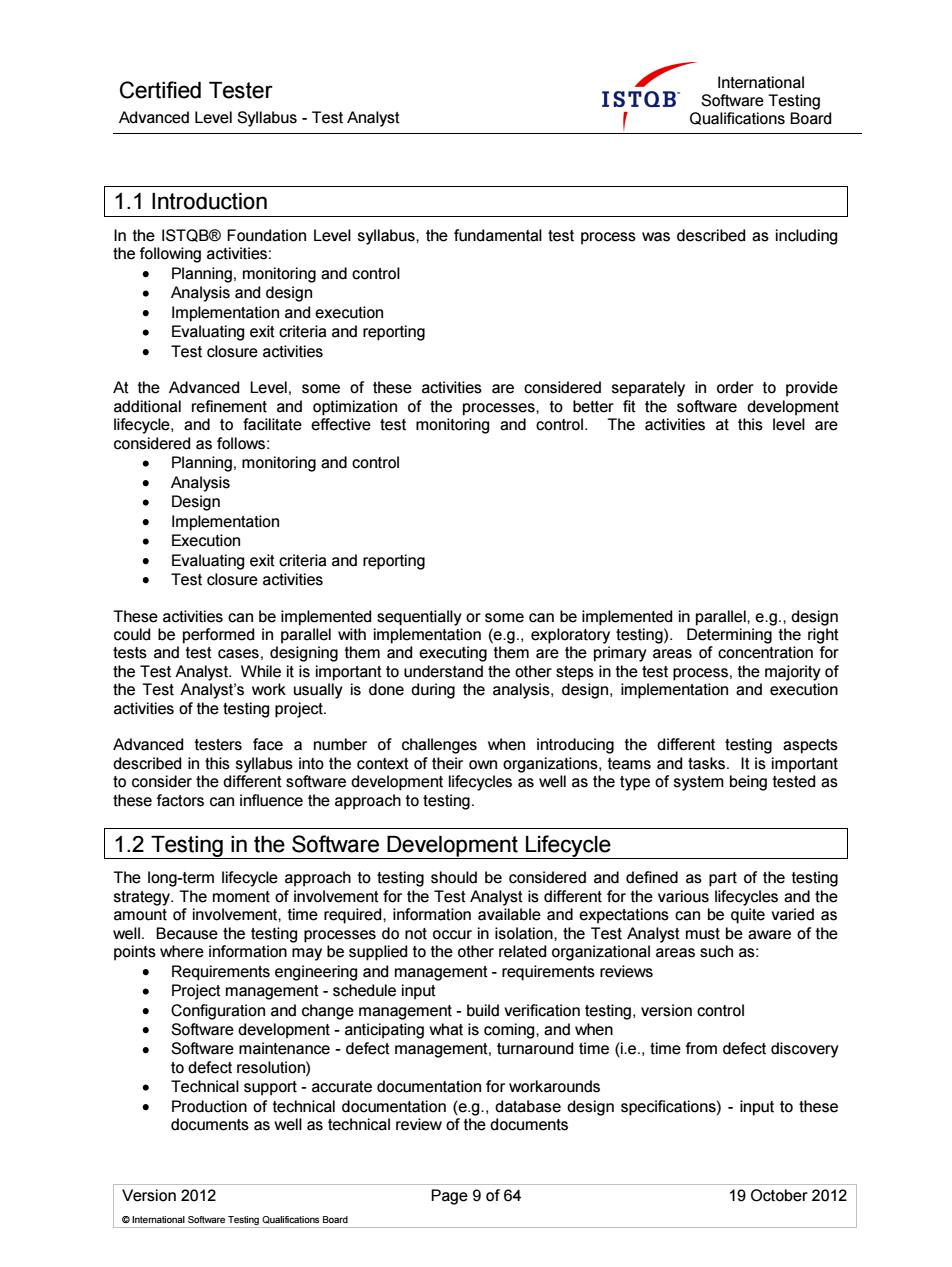正在加载图片...

Certified Tester Advanced Level Syllabus-Test Analyst Qualifications Board 1.1 Introduction oundation Level syllabus,the fundamental test process was described as including monitoring and control Analysis and desian Implementation and execution ria and reporting At the Advanced Level.some of these activities are considered separately in order to provide considered as follows: Planning,monitoring and control Analysis Evaluating exit criteria and reporting Test closure activities These activities can be implemented sequentially or some can be implemented in parallel.e.g..design oe dung the na den.mlemen e parallel w impl menta est A hile it t to under P activities of the testing project. Advanced testers face a number of challenges when introducing the different testing aspects described in this syllabus into the context of the e the to test 1.2 Testing in the Software Development Lifecycle The long life ed an es and the amount of involvement,time required.information avai lable an expectations can be quite varied as pnis of the ment-requirements reviews Project management-schedule input Configuration and change management-build verification testing.version control . efect e(i.e.,time from defect discovery to defect resolution) Technical support-accurate documentation for workarounds duction of tech documentation databas design specifications)input to these Version 2012 Page 9 of 64 19 October 2012 tional Software Testing Board Certified Tester Advanced Level Syllabus - Test Analyst International Software Testing Qualifications Board Version 2012 Page 9 of 64 19 October 2012 © International Software Testing Qualifications Board 1.1 Introduction In the ISTQB® Foundation Level syllabus, the fundamental test process was described as including the following activities: Planning, monitoring and control Analysis and design Implementation and execution Evaluating exit criteria and reporting Test closure activities At the Advanced Level, some of these activities are considered separately in order to provide additional refinement and optimization of the processes, to better fit the software development lifecycle, and to facilitate effective test monitoring and control. The activities at this level are considered as follows: Planning, monitoring and control Analysis Design Implementation Execution Evaluating exit criteria and reporting Test closure activities These activities can be implemented sequentially or some can be implemented in parallel, e.g., design could be performed in parallel with implementation (e.g., exploratory testing). Determining the right tests and test cases, designing them and executing them are the primary areas of concentration for the Test Analyst. While it is important to understand the other steps in the test process, the majority of the Test Analyst’s work usually is done during the analysis, design, implementation and execution activities of the testing project. Advanced testers face a number of challenges when introducing the different testing aspects described in this syllabus into the context of their own organizations, teams and tasks. It is important to consider the different software development lifecycles as well as the type of system being tested as these factors can influence the approach to testing. 1.2 Testing in the Software Development Lifecycle The long-term lifecycle approach to testing should be considered and defined as part of the testing strategy. The moment of involvement for the Test Analyst is different for the various lifecycles and the amount of involvement, time required, information available and expectations can be quite varied as well. Because the testing processes do not occur in isolation, the Test Analyst must be aware of the points where information may be supplied to the other related organizational areas such as: Requirements engineering and management - requirements reviews Project management - schedule input Configuration and change management - build verification testing, version control Software development - anticipating what is coming, and when Software maintenance - defect management, turnaround time (i.e., time from defect discovery to defect resolution) Technical support - accurate documentation for workarounds Production of technical documentation (e.g., database design specifications) - input to these documents as well as technical review of the documents